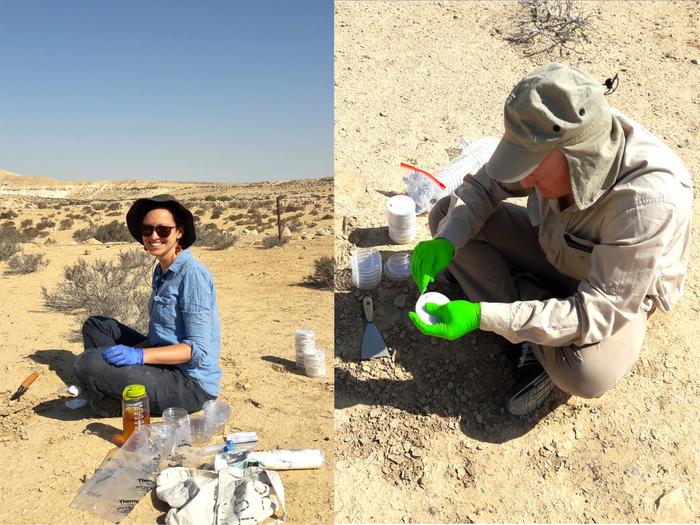Prolonged droughts followed by sudden bursts of rainfall – how do desert soil bacteria manage to survive such harsh conditions? This long-debated question has now been answered by an ERC project led by microbiologist Dagmar Woebken from the Centre for Microbiology and Environmental Systems Science (CeMESS) at the University of Vienna. The study reveals that desert soil bacteria are highly adapted to survive the rapid environmental changes experienced with each rainfall event. These findings were recently published in the prestigious journal Nature Communications.

Credit: S. Imminger und D.V. Meier
Prolonged droughts followed by sudden bursts of rainfall – how do desert soil bacteria manage to survive such harsh conditions? This long-debated question has now been answered by an ERC project led by microbiologist Dagmar Woebken from the Centre for Microbiology and Environmental Systems Science (CeMESS) at the University of Vienna. The study reveals that desert soil bacteria are highly adapted to survive the rapid environmental changes experienced with each rainfall event. These findings were recently published in the prestigious journal Nature Communications.
Drylands cover over 46% of global land area and are expanding, not only due to climate change but also unsustainable land management practices. While plants are seldom encountered in deserts, invisible life thrives belowground. Microorganisms located in the so-called biocrust (the top millimeters to centimeter of the desert soil) enrich the soil with carbon and nitrogen, and also help prevent soil erosion and retain water. But these microbes live in a challenging environment, facing long periods of drought with infrequent rain. Until now, it was unclear how they could maintain important ecosystem functions under such conditions. Using state-of-the-art methods in microbial ecology, Dagmar Woebken’s team gained insights into microbial life in these soils.
Desert soil bacteria endure long drought periods in a state of dormancy, but are reactivated in response to rainfall events, which are short and very rare. The researchers uncovered a kind of “all-in” reactivation strategy in the biocrusts of the Negev Desert, Israel. The bacteria make the most of rainfall events – within this narrow window of activity, almost all microbial soil diversity (as well as individual cells) become active. “When we simulate a rainfall event in the laboratory, we observe that within the first 15 to 30 minutes, almost all taxonomic groups switched from a resting mode to an active mode,” explains Dimitri Meier, co-first author of the study.” This is a remarkable characteristic of desert soil bacteria, as in other types of soil many groups of bacteria take much longer to reactivate.” When reactivated, the bacteria would quickly begin to generate energy and repair their genomes.
In the study, the researchers simulated rainfall events with stable isotope labeled water – water containing heavy hydrogen. Using NanoSIMS, they examined individual cells to see which of them had incorporated the heavy hydrogen atoms. “With this approach, we can reveal the fraction of biocrust cells that reactivate in a rain event. We can also infer if they can grow in short rain events that in arid deserts often only last 1 to 2 days,” explains Stefanie Imminger, PhD candidate and co-first author of the study. “We found that almost all biocrust cells reactivate, but that in these short rain events only a small proportion of the cells would be able to double.” A large proportion of the biocrust cells can therefore use rain events to regenerate and prepare for the next drought, but cell division does not occur.
“These data help us understand how biocrust bacteria make optimal use of the short activity windows they experience in deserts. They are ideally adapted to withstand short-term changes in soil water content, a very stressful situation for the cells. This allows them to survive the sudden increase in water content during rain, as well as the subsequent drying out. Additionally, the diverse microbial community is capable of immediate reactivation, which is of great benefit when it must return to a dormant state within a few hours to days,” says Dagmar Woebken, principal investigator of the study.
The findings of this study are relevant not only for desert areas but also for other regions. The ability to survive water limitation will become increasingly important for soil microorganisms in temperate regions, as the frequency and intensity of droughts is increasing due to climate change. Insights gained from desert soil research can help to understand which features make soil microorganisms successful in surviving these challenges.
Journal
Nature Communications
Article Title
Survival and rapid resuscitation permit limited productivity in desert microbial communities.
Article Publication Date
17-Apr-2024



